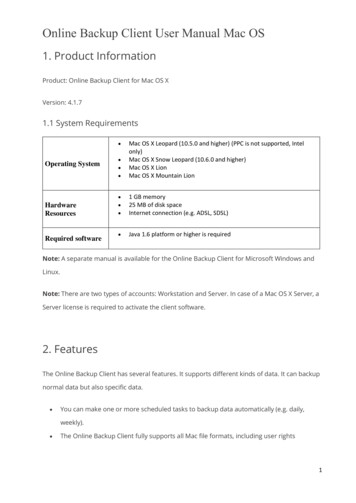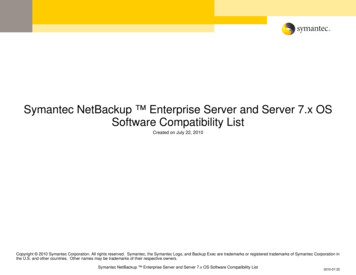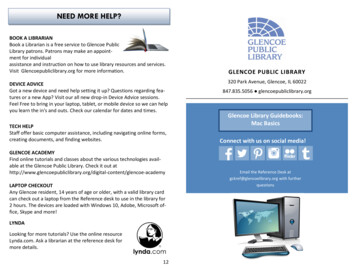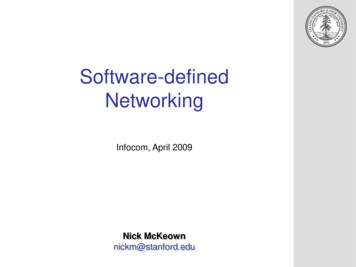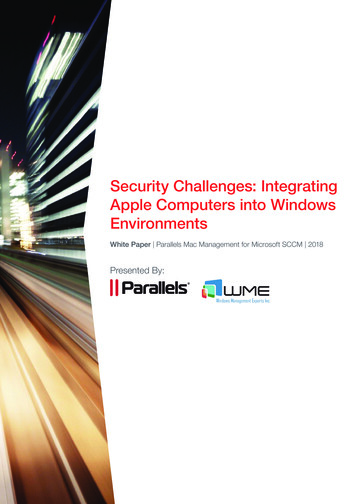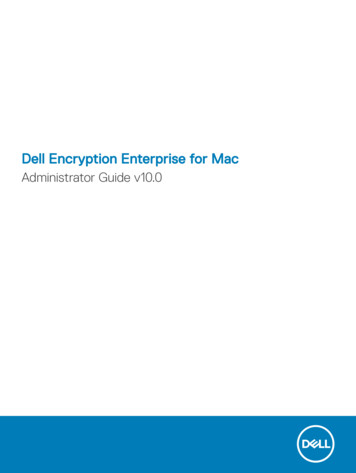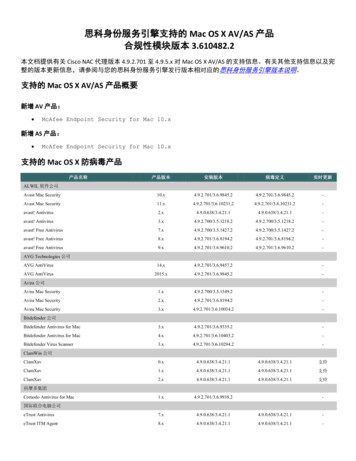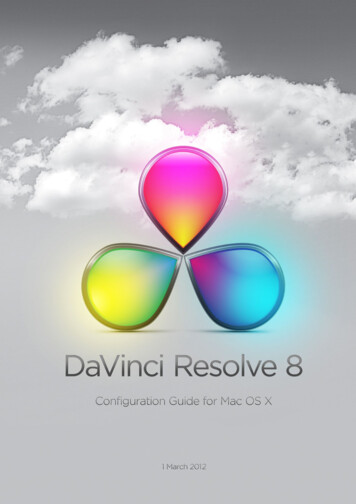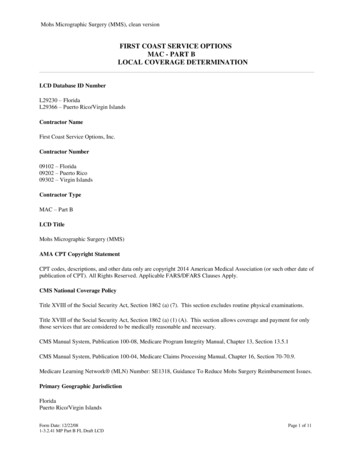
Transcription
Mohs Micrographic Surgery (MMS), clean versionFIRST COAST SERVICE OPTIONSMAC - PART BLOCAL COVERAGE DETERMINATIONLCD Database ID NumberL29230 – FloridaL29366 – Puerto Rico/Virgin IslandsContractor NameFirst Coast Service Options, Inc.Contractor Number09102 – Florida09202 – Puerto Rico09302 – Virgin IslandsContractor TypeMAC – Part BLCD TitleMohs Micrographic Surgery (MMS)AMA CPT Copyright StatementCPT codes, descriptions, and other data only are copyright 2014 American Medical Association (or such other date ofpublication of CPT). All Rights Reserved. Applicable FARS/DFARS Clauses Apply.CMS National Coverage PolicyTitle XVIII of the Social Security Act, Section 1862 (a) (7). This section excludes routine physical examinations.Title XVIII of the Social Security Act, Section 1862 (a) (1) (A). This section allows coverage and payment for onlythose services that are considered to be medically reasonable and necessary.CMS Manual System, Publication 100-08, Medicare Program Integrity Manual, Chapter 13, Section 13.5.1CMS Manual System, Publication 100-04, Medicare Claims Processing Manual, Chapter 16, Section 70-70.9.Medicare Learning Network (MLN) Number: SE1318, Guidance To Reduce Mohs Surgery Reimbursement Issues.Primary Geographic JurisdictionFloridaPuerto Rico/Virgin IslandsForm Date: 12/22/081-3.2.41 MP Part B FL Draft LCDPage 1 of 11
Mohs Micrographic Surgery (MMS), clean versionOversight RegionRegion IOriginal Determination Effective Date02/02/2009 – Florida03/02/2009 – Puerto Rico/Virgin IslandsOriginal Determination Ending DateN/A/Revision Effective DateMM/DD/YYYYRevision Ending DateMM/DD/YYYYIndications and Limitations of Coverage and/or Medical NecessityMohs micrographic surgery (MMS) is a microscope-guided tissue-sparing surgical procedure used for the removal ofcertain complex or ill-defined cutaneous neoplasms of the skin and histologic examination of 100% of the surgicalmargins. MMS uses precise measurements of tumor margins to remove cancerous cells and leave healthy tissueintact. The procedure is performed in successive stages to remove extensive tumors, as needed. The surgery requiresthe integration of an individual functioning in two separate and distinct capacities: surgeon and pathologist. If eitherof these responsibilities is delegated to another physician or other qualified health care professional who reports theservice(s) separately, the MMS codes should not be reported.The majority of skin cancers can be managed by excision or destruction techniques. MMS is usually an officeprocedure done under local anesthesia and/or sedation.To support medical review (post procedure prepayment or post payment audit) of documentation, this LCD addressesthe reasonable and necessary threshold for coverage based on three requirements—1) Qualifications of the physician and office/facility team (See Limitations section.);2) Characteristics of the lesion pre-procedure (See Indications section.);3) Documentation of the medical need for the Mohs micrographic technique and associated plans for the repair.Procedures that exceed the medical need are not reasonable and necessary (not a Medicare covered service),therefore, documentation (pre-procedure E/M note and/or post-procedure operative notes) must address (a) whythe lesion will not be (was not) managed by standard excision or destruction technique and (b) why procedures(when utilized or referred to a plastic surgeon) for complex repair, adjacent tissue transfer or rearrangement, flap,or graft codes are employed. These procedures are based on lesion location and complexity and may be subject toprepayment medical review. The options for care must also be discussed with the patient and documented. (SeeDocumentation Requirements section.)Mohs surgery leaves an open wound, which most often is reconstructed (closed) by the Mohs surgeon. Some woundmanagement is included in the intra and post service work of the Mohs surgery codes, and the Mohs surgeon has theoption of repair (closure) codes as appropriate. Per CPT codebook, if repair (closure) is performed, the Mohs surgeonmay report separate repair, adjacent tissue transfer or rearrangement, flap, or graft codes when medically reasonableand necessary. The guidelines at the beginning of applicable sections of the CPT codebook define items that areForm Date: 12/22/081-3.2.41 MP Part B FL Draft LCDPage 2 of 11
Mohs Micrographic Surgery (MMS), clean versionnecessary to report services and procedures. Also, there are other instructions (such as parenthetical notes withselected codes) that may restrict the use of certain additional procedure codes. Physicians must code to specificityand code correctly. The National Correct Coding Initiative edits applicable to certain procedures must not becircumvented.Indications:Characteristics of the lesion pre-procedure:The appropriate use criteria recommendations (supported by AAD/ACMS/ASDSA/ASMS) provide a necessarystarting point for consideration of Mohs micrographic surgical treatment of a lesion. However, Mohs MicrographicSurgery is indicated only when the superficial (lateral) or deep margins of the cancer lesion are uncertain clinicallyAND the likelihood of surgical cure and reconstruction would be compromised without use of immediatemicroscopic examination of the surgical margins. Though complexity of the lesion (poorly defined borders,suspected deep invasion, recurrent lesion, prior radiation), lesion size/location, and maximum conservation of healthytissue are to be addressed in the preoperative medical record, the surgeon must address why the lesion will not be(was not) managed by excision or destruction technique.Current accepted diagnoses and indications for Mohs Micrographic Surgery (one of three requirements for coverage):A. Basal cell carcinomas (BCC), squamous cell carcinomas (SCC), basalosquamous/basosquamous cell carcinomasin anatomic locations H and M (except as non-covered in the Limitations section).--Area H: “Mask areas” of face (central face, eyelids [including inner/outer canthi], eyebrows, nose, lips[cutaneous/mucosal/vermillion], chin, ear and periauricular skin /sulci, temple), genitalia (including perinealand perianal), hands, feet, nail units, ankles, and nipples/areolaArea M: Cheeks, forehead, scalp, neck, jawline, pretibial surfaceB. Basal cell carcinomas (BCC), squamous cell carcinomas (SCC), or basalosquamous/basosquamous cellcarcinomas that are in anatomic locations H, M, and L (trunk and extremities) regardless of subtype, size, ordepth arising in (except as non-covered in the Limitations section):-Prior radiated skinTraumatic scarArea of osteomyelitisArea of chronic inflammation/ulcerationPatients with genetic syndromesC. Certain recurrent skin cancers (except as non-covered in the Limitations section):-Recurrent aggressive BCC, nodular BCC, superficial (except area L) BCC of any size, or unexpectedpositive margin on recent excision (healthy or immunocompromised patients with genetic syndromes)Recurrent aggressive SCC, verrucous SCC, KA-type SCC (not central facial), in situ/Bowen SCC of anysize or unexpected positive margin on recent excision (healthy or immunocompromised patients, or patientswith genetic syndromes)D. Lentigo maligna, melanoma in situ, non-lentigo maligna - primary or locally recurrent in Areas H, M, L whenclinical staging, work-up, and surgical treatment consistent with NCCN guidelines.E. Less common skin cancers (except as non-covered in the Limitations section):-Adenocystic carcinomaAdnexal carcinomaForm Date: 12/22/081-3.2.41 MP Part B FL Draft LCDPage 3 of 11
Mohs Micrographic Surgery (MMS), clean version-AngiosarcomaApocrine/eccrine carcinomaAtypical FibroxanthomaDermatofibrosarcoma protuberansExtramammary Paget’s DiseaseLeiomyosarcomaMalignant fibrous histiocytoma/undifferentiated pleomorphic sarcomaMerkel cell carcinomaMicrocystic adnexal carcinomaMucinous carcinomaSebaceous carcinomaLimitations:Qualifications of the physician and office/facility team (one of three requirements for coverage):The Centers for Medicare & Medicaid Services (CMS) Online Manual System, Publication 100-08, MedicareProgram Integrity Manual, Chapter 13, Section 13.5.1 outlines that “reasonable and necessary” services are“ordered and/or furnished by qualified personnel.” Services will be considered medically reasonable and necessaryonly if performed by appropriately trained providers.Providers of Mohs surgery are limited to physicians (i.e., MD/DO) as follows: Enrolled in Medicare and a licensed physician who has completed Residency training in Dermatology orgeneral/subspecialty surgery AND has completed additional medical training in Mohs surgery. This additionaltraining and expertise must be verifiable. Verification of this training should be available if requested during apre or post payment medical review. Examples of verification are letter/certificate confirming fellowshipprogram (program certified by a nationally recognized organization); residency program with letter confirmingadequate MMS training (program certified by a nationally recognized organization); credible post-graduatetraining course/program covering Mohs micrographic surgery technique and pathology identification; crediblepreceptorship with demonstrated case experience and expertise. While Mohs surgery is a technical method of tissue handling and processing, the training and expertise of thesurgeon greatly impacts the clinical outcome. The surgeon must act as the pathologist for all tissue sections(reliably read the frozen section pathology) and often must function as the reconstructive surgeon. The qualified physician must provide services in the appropriate setting for the patient’s medical need andcondition. Success requires good tissue handling, good surgical technique, and standard of care tissue processingand staining technique. The Mohs surgery facility must meet standards of care as most are not affiliated withhospital delivery systems. A typical facility consists of procedure rooms suitable for dermatological surgerylocated in close proximity to a fully-equipped Mohs laboratory. The necessary equipment for Mohs cases of allcomplexities is available per standards of care. The Mohs laboratory typically has standard of care equipmentsuch as cryostats, staining facilities (manual and/or automated) for standard staining of Mohs sections. There isaccess to appropriate immunohistochemical staining for selected Mohs cases. The setting must include a Mohshistolaboratory technician who will be either dedicated or one of a small team of biomedical staff who regularlycut Mohs sections and do sufficient numbers per week to maintain a high technical expertise in preparing Mohssections. Though this LCD lists covered diagnosis codes, diagnosis alone does not indicate coverage. The documentationin the medical record for the beneficiary must support that the claim met the criteria outlined in the policy.Form Date: 12/22/081-3.2.41 MP Part B FL Draft LCDPage 4 of 11
Mohs Micrographic Surgery (MMS), clean versionThe limitations listed in sections 1-5 below refer to specific body areas and lesion characteristics. The use ofMohs Micrographic Surgery in these areas and for these conditions is not considered medically reasonable andnecessary:1. Both recurrent and primary actinic keratosis (AK) with focal SCC in situ; Bowenoid AK; SCC in situ (AKtype) of any size in all areas in healthy or immunocompromised patients.2. Basal cell carcinoma located in Area L— trunk and extremities (excluding pretibial surface, hands, feet,nail units, and ankles): Recurrent superficial BCC (healthy or immunocompromised patients, or patients with genetic syndromes) of anysize Primary superficial BCC (healthy or immunocompromised patients) of any size Primary nodular BCC (healthy patients) 2 cm Primary nodular BCC (immunocompromised patients) 1 cm3. Squamous cell carcinoma located in Area L— trunk and extremities (excluding pretibial surface, hands,feet, nail units, and ankles): Primary SCC; without aggressive histologic features, 2 mm depth without other defining features, Clark level III (healthy patients) 2 cm Primary SCC keratoacanthoma (KA) type; not central facial (healthy patients) 1 cm Primary in situ SCC/Bowen disease (healthy patients) 2 cm Primary in situ SCC/Bowen disease (immunocompromised patients) 1 cm4. Desmoplastic trichoepithelioma located in Area L— trunk and extremities (excluding pretibial surface,hands, feet, nail units, and ankles)5. Bowenoid papulosisCPT/HCPCS Codes17311Mohs micrographic technique, including removal of all gross tumor, surgical excision of tissue specimens,mapping, color coding of specimens, microscopic examination of specimens by the surgeon, andhistopathologic preparation including routine stain(s) (eg, hematoxylin and eosin, toluidine blue), head,neck, hands, feet, genitalia, or any location with surgery directly involving muscle, cartilage, bone, tendon,major nerves, or vessels; first stage, up to 5 tissue blocks17312each additional stage after the first stage, up to 5 tissue blocks (List separately in addition to codefor primary procedure)17313Mohs micrographic technique, including removal of all gross tumor, surgical excision of tissue specimens,mapping, color coding of specimens, microscopic examination of specimens by the surgeon, andhistopathologic preparation including routine stain(s) (eg, hematoxylin and eosin, toluidine blue), of thetrunk, arms, or legs; first stage, up to 5 tissue blocks17314each additional stage after the first stage, up to 5 tissue blocks (List separately in addition to codefor primary procedure)17315Mohs micrographic technique, including removal of all gross tumor, surgical excision of tissue specimens,mapping, color coding of specimens, microscopic examination of specimens by the surgeon, andhistopathologic preparation including routine stain(s) (eg, hematoxylin and eosin, toluidine blue), eachadditional block after the first 5 tissue blocks, any stage (List separately in addition to code for primaryprocedure)Form Date: 12/22/081-3.2.41 MP Part B FL Draft LCDPage 5 of 11
Mohs Micrographic Surgery (MMS), clean versionICD-9 Codes that Support Medical 72Malignant neoplasm of upper lip, vermilion borderMalignant neoplasm of lower lip, vermilion borderMalignant neoplasm of upper lip, inner aspectMalignant neoplasm of lower lip, inner aspectMalignant neoplasm of lip, unspecified, inner aspectMalignant neoplasm of commissure of lipMalignant neoplasm of other sites of lipMalignant neoplasm of lip, unspecified, vermilion borderMalignant neoplasm of anal canalMalignant neoplasm of nasal cavitiesMalignant neoplasm of maxillary sinusMalignant neoplasm of frontal sinusMalignant melanoma of skin of lipMalignant melanoma of skin of eyelid, including canthusMalignant melanoma of skin of ear and external auditory canalMalignant melanoma of skin of other and unspecified parts of faceMalignant melanoma of skin of scalp and neckMalignant melanoma of skin of trunk, except scrotumMalignant melanoma of skin of upper limb, including shoulderMalignant melanoma of skin of lower limb, including hipMalignant melanoma of other specified sites of skinBasal cell carcinoma of skin of lipSquamous cell carcinoma of skin of lipOther specified malignant neoplasm of skin of lipBasal cell carcinoma of eyelid, including canthusSquamous cell carcinoma of eyelid, including canthusOther specified malignant neoplasm of eyelid, including canthusBasal cell carcinoma of skin of ear and external auditory canalSquamous cell carcinoma of skin of ear and external auditory canalOther specified malignant neoplasm of skin of ear and external auditory canalBasal cell carcinoma of skin of other and unspecified parts of faceSquamous cell carcinoma of skin of other and unspecified parts of faceOther specified malignant neoplasm of skin of other and unspecified parts of faceBasal cell carcinoma of scalp and skin of neckSquamous cell carcinoma of scalp and skin of neckOther specified malignant neoplasm of scalp and skin of neckBasal cell carcinoma of skin of trunk, except scrotumSquamous cell carcinoma of skin of trunk, except scrotumOther specified malignant neoplasm of skin of trunk, except scrotumBasal cell carcinoma of skin of upper limb, including shoulderSquamous cell carcinoma of skin of upper limb, including shoulderOther specified malignant neoplasm of skin of upper limb, including shoulderBasal cell carcinoma of skin of lower limb, including hipSquamous cell carcinoma of skin of lower limb, including hipForm Date: 12/22/081-3.2.41 MP Part B FL Draft LCDPage 6 of 11
Mohs Micrographic Surgery (MMS), clean .8233.5Other specified malignant neoplasm of skin of lower limb, including hipBasal cell carcinoma of other specified sites of skinSquamous cell carcinoma of other specified sites of skinOther specified malignant neoplasm of other specified sites of skinMalignant neoplasm of nipple and areola of female breastMalignant neoplasm of nipple and areola of male breastMalignant neoplasm of vaginaMalignant neoplasm of labia majoraMalignant neoplasm of labia minoraMalignant neoplasm of glans penisMalignant neoplasm of body of penisMalignant neoplasm of scrotumMerkel cell carcinoma of the faceMerkel cell carcinoma of the scalp and neckMerkel cell carcinoma of the upper limbMerkel cell carcinoma of the lower limbMerkel cell carcinoma of the trunkMerkel cell carcinoma of other sitesCarcinoma in situ of skin of lipCarcinoma in situ of skin of eyelid, including canthusCarcinoma in situ of skin of ear and external auditory canalCarcinoma in situ of skin of other and unspecified parts of faceCarcinoma in situ of skin of scalp and skin of neckCarcinoma in situ of skin of trunk, except scrotumCarcinoma in situ of skin of upper limb, including shoulderCarcinoma in situ of skin of lower limb, including hipCarcinoma in situ of other specified sites of skinCarcinoma in situ of penisDiagnoses that Support Medical NecessityN/AICD-9 Codes that DO NOT Support Medical NecessityN/ADiagnoses that DO NOT Support Medical NecessityN/AAssociated InformationDocumentation Requirements(One of three requirements for coverage): Documentation supporting the medical necessity of the procedure(s) should be legible, maintained in thepatient’s medical record, and made available to Medicare upon request.Form Date: 12/22/081-3.2.41 MP Part B FL Draft LCDPage 7 of 11
Mohs Micrographic Surgery (MMS), clean version Procedures that exceed the medical need are not reasonable and necessary (not a Medicare covered service),therefore, documentation (pre-procedure E/M note and/or post-procedure operative notes) must address (a) whythe lesion will not be (was not) managed by standard excision or destruction technique and (when applicable) (b)why (when utilized or referred to a plastic surgeon) procedures for complex repair, adjacent tissue transfer orrearrangement, flap, or graft codes are employed. The physician must document in the patient’s medical recordthat the diagnosis is appropriate for MMS and that MMS is an appropriate choice as the treatment of theparticular lesion. The options for care (both the primary procedure options and repair options) must bediscussed with the patient and clearly noted in the pre-procedure (or post procedure as appropriate)documentation. In summary, the minimal medical need documentation entails that the beneficiary was informedof their treatment options and explained the risks/benefits of the MMS technique and associated repair. Operative notes and pathology documentation in the patient’s medical record should clearly show that MMS wasperformed using accepted MMS technique, in which the physician acts in two integrated and distinct capacities:surgeon and pathologist (therefore confirming that the procedure meets the definition of the CPT code(s)). Operative documentation should note: location, number, and size of the lesion(s); number of stages performed;number of specimens per stage. Histology documentation must include the following: (a) First stage: if tumorpresent, depth of invasion; pathological pattern of the tumor; cell morphology; if present, note perineuralinvasion of scar tissue. (b) Subsequent stages: if the tumor characteristics are the same as in the first stage, notethis fact only. If the tumor characteristics are different from the first stage, describe the differences. Measurement of the primary lesion necessitating MMS and measurements in support of repair or relatedprocedures (such as but not limited to adjacent tissue transfer/rearrangements, grafts/flaps) completing the MMSprocedure and confirming the primary defect measurement or other relevant measurements should be verifiable.Documentation of the clinical tumor border definition may be accomplished by preoperative photography withthe skin stretched to delineate the visible clinical borders with or without debulking curettage (using a centimeterruler or relation of size by another anatomic structure). Postoperative photography to document the defect mayalso be considered, especially for small lesions that have a significant subepithelial component (i.e., tip of theiceberg phenomenon). It is understood that photographic documentation may not be possible in a smallpercentage of cases because of technical difficulties. When the surgical defect created by MMS requires reconstruction, it should be clear on the documentation thatthe reconstructive technique performed was an appropriate choice to preserve functional capabilities and torestore physical appearance. If the 59 modifier is used with a skin biopsy/pathology code on the same day the MMS was performed, physiciandocumentation must clearly indicate the following: either the biopsy was performed on a lesion other than thelesion on which the MMS was performed, or if the biopsy is of the same lesion on which the MMS wasperformed, the documentation must support that the patient did not have a prior biopsy of the lesion within theprevious 60 days.Utilization GuidelinesIt is expected that these services would be performed as indicated by current medical literature and/or standards ofpractice. When services are performed in excess of established parameters, they may be subject to review formedical necessity.Sources of Information and Basis for DecisionAlam M, Ratner D. (2002). Cutaneous squamous cell carcinoma. New England Journal of Medicine, 344 (13): 975983.American College of Mohs Surgery (2011). Why choose a fellowship trained Mohs surgeon? Retrieved fromhttp://www.skincancermohssurgery.orgForm Date: 12/22/081-3.2.41 MP Part B FL Draft LCDPage 8 of 11
Mohs Micrographic Surgery (MMS), clean versionBialy TL, Whalen J, Veledar E, Lafreniere D, Spiro J, Chartier T, Chen SD (2004). Mohs micrographic surgery vstraditional surgical incision: A cost comparison analysis. Archives of Dermatology. Vol. 140 (6). Retrieved fromhttp://archderm.ama-assn.orgBichakjian CK, Halpern AC, Johnson TM, et al. (November 2011). Guidelines of care for the management ofprimary cutaneous melanoma. Journal of American Academy of Dermatology, 65(5):1032-47.Cigna (coverage position number: 0116) Mohs’ Micrographic Surgery.Connolly SM, Baker DR, Coldiron BM, Fazio MJ, et al. (October 2012). AAD/ACMS/ASDSA/ASMS 2012appropriate use criteria for Mohs micrographic surgery: A report of the American Academy of Dermatology,American College of Mohs Surgery, American Society for Dermatologic Surgery Association, and the AmericanSociety for Mohs Surgery. Journal of American Academy of Dermatology, 67: 531-550.Current Procedural Terminology (CPT ), Professional Edition (2014). American Medical Association.Green A, Marks R. (2002). Squamous cell carcinoma of the skin: Non-metastatic. Clinical Evidence, 7: 1549-1554.Martinez JC, Otley CC. (2001). The management of melonoma and nonmelanoma skin cancer: A review of theprimary care physician. Mayo Clinic Proceedings, 76(12): 1253-1265.Miller, Alexander. (September 2013). Documenting Mohs Surgery. Dermatology World, pages 4-5. Retrieved fromhttp://www.aad.org/dw.Murad A, Helenowski IB, Cohen JL, et al. (January 2013) Association Between Type of Reconstruction After MohsMicrographic Surgery and Surgeon-, Patient-, and Tumor-Specific Features: A Cross-Sectional Study. DermatologicSurgery, 39(1): 51-55.National Guideline Clearinghouse (NGC). Multi-professional guidelines for the management of the patient withprimary cutaneous squamous cell carcinoma. (2010). Retrieved from the Agency for Healthcare Research and Quality(AHRQ). Accessed at: http://www.guideline.gov/content.aspx?id 15882.NCCN Clinical Practice Guidelines in Oncology (NCCN Guidelines ) for Basal Cell and Squamous Cell SkinCancers, Version 2.2014.NCCN Clinical Practice Guidelines in Oncology (NCCN Guidelines ) for Melanoma, Version 4.2014.Novitas Solutions, Inc. LCD for Mohs' Micrographic Surgery (MMS) (L32627)Other MAC Contractor’s LCDsSclafani AP, et al. (June 2012). Successes, revisions, and postoperative complications in 446 Mohs defect repairs.Facial Plastic Surgery, 28(3):358-66.The Skin Cancer Foundation. (2013). Basal cell carcinoma treatment options. Retrieved ion/basal-cell-carcinoma/bcc-treatment-optionsThe Skin Cancer Foundation. 2013).Mohs micrographic surgery. Retrieved from ohs-surgery/mohs-surgery-saving-face]Form Date: 12/22/081-3.2.41 MP Part B FL Draft LCDPage 9 of 11
Mohs Micrographic Surgery (MMS), clean versionStart Date of Comment PeriodN/AEnd Date of Comment PeriodN/AStart Date of Notice Period08/22/2014Revision HistoryRevision History Number: R2Revision Number: 4Publication: December 2014 ConnectionLCR B2014-xxxExplanation of revision: The local coverage determination (LCD) was revised to update the following sections:“Coverage Indications, Limitations, and/or Medical Necessity,” “Indications,” “Limitations,” and “DocumentationRequirements.” Language in these sections was revised to make the intent of the LCD clearer – coverage is based oncharacteristics of the lesion, qualifications of the performing physician, and documentation of medical need in themedical record. Medical need entails that the beneficiary was informed of their treatment options and explained therisk/benefits of the MMS technique and associated repair. The qualifications of the performing physician must beverifiable if requested by the Contractor, and examples of verification were expanded based on the varying input bythe different physician specialties and their societies that have an interest in the MMS technique. The effective date ofthis revision is based on date of service.Revision History Number: R1Revision Number: 3Publication: August 2014 ConnectionLCR B2013-054Explanation of Revision: Major revisions were made throughout the entire LCD. In addition, ICD-9 codes 154.2,172.0, 172.1, 172.2, 172.3, 172.4, 172.5, 172.6, 172.7, 172.8, 174.0, 175.0, 184.0, 184.1, 184.2, 187.2, 187.3, 187.7,and 233.5 were added to the LCD; and ICD-9 codes 173.00, 173.10, 173.20, 173.30, 173.40, 173.50, 173.60, 173.70,and 173.80 were removed from the LCD. The effective date of this revision is based on date of service.Revision Number:Start Date of Comment Period:Start Date of Notice Period:Revised Effective Date:2N/A10/01/201110/01/2011LCR B2011-101September 2011 ConnectionExplanation of Revision: Annual 2012 ICD-9-CM Update. Deleted diagnosis codes 173.0, 173.1, 173.2, 173.3,173.4, 173.5, 173.6, 173.7 and 173.8. Added new diagnosis codes 173.00-173.09, 173.10-173.19, 173.20-173.29,173.30-173.39, 173.40-173.49, 173.50-173.59, 173.60-173.69, 173.70-173.79, and 173.80-173.89. The effective dateof this revision is based on date of service.Revision Number:Form Date: 12/22/081-3.2.41 MP Part B FL Draft LCD1LCR B2010-025Page 10 of 11
Mohs Micrographic Surgery (MMS), clean versionStart Date of Comment Period:Start Date of Notice Period:Revised Effective Date:N/A02/01/201010/01/2009January 2010 UpdateExplanation of Revision: Annual 2010 ICD-9-CM Update. Added diagnosis code range 209.31-209.36 withdescriptors for Merkel cell carcinoma. This revision is effective for claims processed on or after 01/19/2010 for datesof service on or after 10/01/2009.Revision NumberStart Date of Comment Period:Start Date of Notice Period:Original Effective DateOriginalN/A12/04/200802/02/2009 – Florida03/02/2009 – Puerto Rico/Virgin IslandsLCR B2009-044FLLCR B2009-045PR/VIDecember 2008 UpdateThis LCD consolidates and replaces all previous policies and publications on this subject by the carrier predecessorsof First Coast Service Options, Inc. (Triple S and FCSO).For Florida (00590) this LCD (L29230) replaces LCD L5953 as the policy in notice. This document (L29230) iseffective on 02/02/2009.For Puerto Rico (00973) and Virgin Islands (00974) there was no previous LCD on this subject. This document(L29366) is effective on 03/02/2009.Related DocumentsN/ALCD AttachmentsCoding GuidelinesDocument formatted: 12/18/2014 (RA/et)Form Date: 12/22/081-3.2.41 MP Part B FL Draft LCDPage 11 of 11
FIRST COAST SERVICE OPTIONS MAC - PART B LOCAL COVERAGE DETERMINATION LCD Database ID Number L29230 - Florida L29366 - Puerto Rico/Virgin Islands Contractor Name First Coast Service Options, Inc. Contractor Number 09102 - Florida 09202 - Puerto Rico 09302 - Virgin Islands Contractor Type MAC - Part B LCD Title
